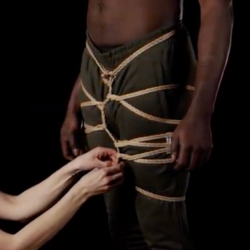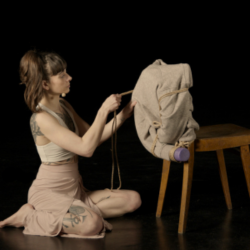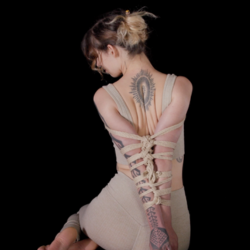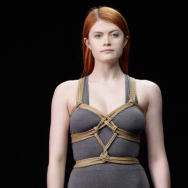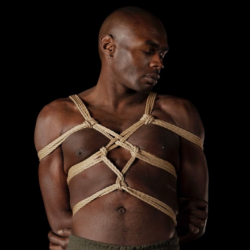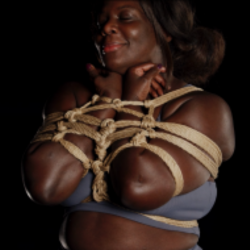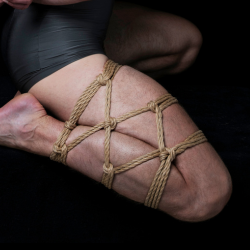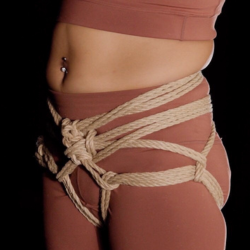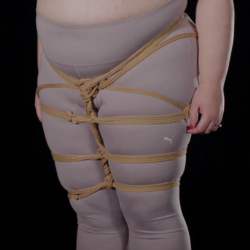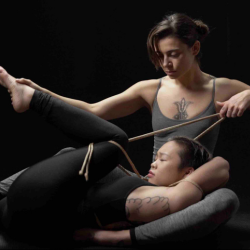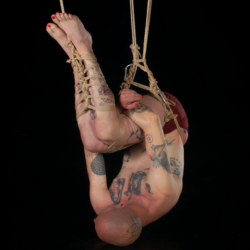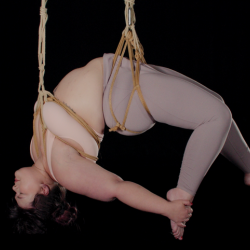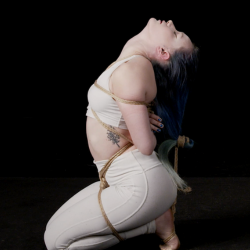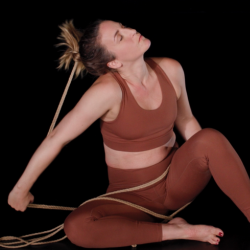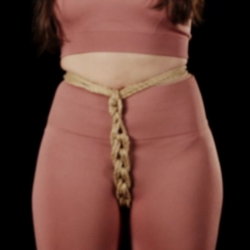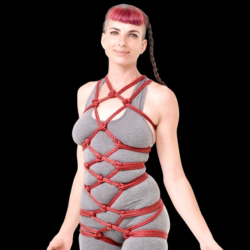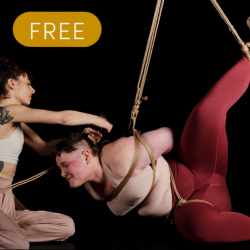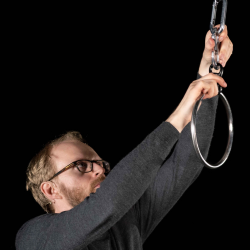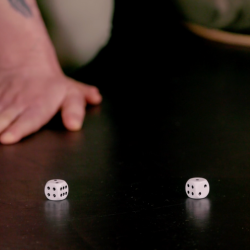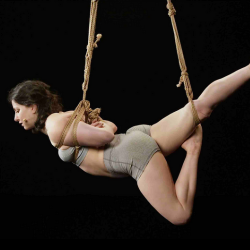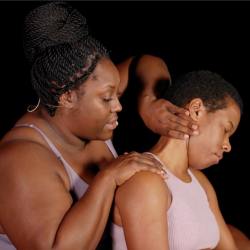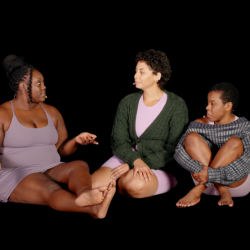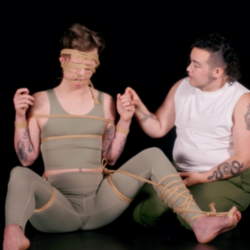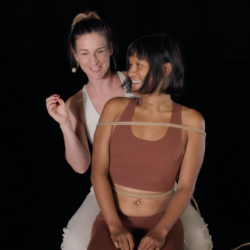EP 38
NAWA MUSUBI
Jake and Laced, also known as Nawa Musubi, discuss their approach to shibari and teaching philosophies. They emphasize the importance of communication and adaptation in their practice, highlighting personal growth, inclusivity, and the evolving recognition of models in the community.

Nawa Musubi is the partnership of Jake and Laced. It was formed in April 2018 when Jake was officially certified by Hajime Kinoko as an instructor of his style of shibari. Jake and Laced are passionate rope educators, with a strong emphasis on the education of the rope model as much as that of the rigger.
They regularly hold workshops and performances across Australia and the Oceania region, including Japan, as well as collaborations with musicians and artists on their projects.
Instagram: @nawa_musubi
[00:00:09] Wicked Wren Hello to all my guys, gals and non-binary pals, welcome to the Shibari Study Podcast. Shibari Study is an online learning resource offering video tutorials for beginners through advanced practitioners. Whether you're new to the world of shibari and needing to learn the basics, or a seasoned rigger or rope bottom seeking inspiration to push your practice to new places, there's something for you at shibaristudy.com. Today we have a very fun episode. We have on two people. We have on Jake who uses he/him and Laced, she/her. They are a Brisbane-based tying pair. They're educators, performers and artists. They have a very unique approach to rope and we're going to get into that today. We're gonna talk about a lot of things. How are you two?
[00:01:01] Jake Very well, thank you.
[00:01:03] Laced Good. Happy to be here.
[00:01:05] Wicked Wren I am extremely excited because I am not only speaking to two amazing rope artists, but also one of you has many Oingo Boingo tattoos.
[00:01:19] Jake That would be me.
[00:01:22] Wicked Wren I feel honored.
[00:01:25] Jake As you might know, the first tattoo, you aim for something small, so I was using the Oingo Boingo secret society picture. The skull in the cowboy hat. And then next time I was like, I'll add to that, and I'll add the album covers and add quotes and everything else and just escalated.
[00:01:44] Wicked Wren I love that. I feel like those are the coolest tattoos. Things that are super, super niche and meaningful to that person. It's very cool.
[00:01:54] Jake Yeah, it's always good when someone recognizes it, you know, just randomly in the street. Oh, that's that album, or, I love that band.
[00:02:02] Wicked Wren And Laced, you were saying that you're afraid of heights, but you're an aerialist and you have a huge rig in your backyard that you do stuff on.
[00:02:15] Laced I can't climb a ladder, but I can climb silk seven meters into the sky and wrap myself up and fall that far to the ground. But I think, like a lot of aerialists are the same. But I'm terrified of heights.
[00:02:28] Wicked Wren I was about to ask, are a lot of aerialists like that? This is a very common thing.
[00:02:33] Laced I think it might be. Like, I don't think any of us are very good at, you know, climbing ladders or walking on the ground. We trip over a lot.
[00:02:40] Wicked Wren That is another thing that I see. All y'all are really bad at just normal walking.
[00:02:46] Laced Yeah, yeah. Very clumsy. Good in the air, clumsy on the ground.
[00:02:50] Wicked Wren I love that. I love that. I'm really excited to talk to you both, because your approach to rope bondage is not the typical approach. You're more focused on the artistic side of things rather than the (…) side of things.
[00:03:07] Jake Yes. So for me personally, we like, like teaching how to do things. What you do with it is your own personal decision. And I like to keep my private side, so I feel that the (…) side is a private thing. So I'll do that at home with my partner sort of thing. I might hint in class that you could do some fun things, but that it's all more... Imagine you're doing it in an actual classroom or in public type of thing.
[00:03:39] Wicked Wren Yeah. Laced, how does that fall in with you? And you're an aerialist, like we were saying?
[00:03:46] Laced Yeah. So for me, it's, you know, it's about... It's a journey. Like being in rope, whether we're teaching or performing, it's, it's a journey for me that process. So it's very internalized. So it's not, it's not so much about the (…) side of it when we're doing that sort of thing. It never really has been for us anyway.
[00:04:08] Wicked Wren When you say it's internalized, what does that mean exactly? What are those feelings that you're having inside?
[00:04:16] Laced Okay. So this is going to go deep. Getting into rope for me, I, gosh, it was a way of processing, you know, a lot of past abuse, I guess. So for me, it was, it was my way to get back into touch with my body to feel connected to my body and to be able to process things. So from there, once I got all that together, it was the journey of pushing myself a bit further, you know, to feel those, that catharsis and release and stuff. So, yeah. Yes.
[00:04:48] Wicked Wren Was there a time where you had to recenter and relearn yourself in order to experience more in rope, if that makes sense?
[00:04:58] Laced Yeah. Definitely. I think it was very step by step. So, you know, when we first, when I first entered, I met Jake not long after that. So it was very much a, you know, as he learned, I learned to process all these things myself and, you know, get better with my body and, you know, just connecting mind to body. Rope's great for connecting mind to body for me.
[00:05:22] Wicked Wren How long before your rope intro had you been doing aerial stuff?
[00:05:28] Laced Okay, so I started aerials after rope. So a couple of years in. Yeah. So I used to – when I first started rope, I was super tiny and super flexible. And now I'm like stronger and less flexible and heavier.
[00:05:42] Wicked Wren How does that feel? Because I think a lot of women are afraid to be strong and not as flexible. That's seen as a very stereotypically valuable skill set as a woman. Has that brought up anything?
[00:05:57] Laced It's huge as a woman and especially as a rope model thing as well. I think we all like have to deal with that. But that takes time and processing. But also it's, it's nice to be strong. And like for me, when I'm teaching rope models as well, it's about using the strength in your body so we don't get injured and so we can progress the way that we want to. So, you know, and I have like people have complimented like, Oh, you're so strong, and that makes you feel better.
[00:06:25] Wicked Wren I want to touch on something a little bit later that you said. You said it's harnessing your strength to not get injured. That's huge. Before we talk about that, I want to hear a little bit about Jake and your intro into this. How did you find (…)? How did you know that you were (…)?
[00:06:49] Jake I'm not sure I'm that (…), to be honest, but I, I've always had the view that, like, you can't be pigeonholed. The world's so big, so, like... I've always looked at the outside, all the different alternatives and enjoyed bits and pieces of each. With the (…) scene, as I've mentioned, my ex started getting into the local scene and eventually I came through, went, Tthis is really cool. People are all different, all different persuasions and (…) and they all got on really well from the outside. I mean, like any community, it's always when you delve deeper, things are going on. But, it was just this, Hey, these are my people, that they all have the same thoughts that (…) people tend to be quite intelligent and educated, but they... They don't put it out there like... What he said... Like like as a, an ego usually with. So meeting these people and go, Hey, they do this thing, it looks different, but I can see how they're getting enjoyment. It's not hurting anyone. And it's, it's fixing an issue in, in an alternate way. Like... When we started, there was so many different (…) going on that I'd see. And then ropes come about, went, This is something that was really good for me, being surprisingly, introverted and shy and not very good at communication. I found rope was really good to be able to communicate to someone without talking and still have a wonderful time just reading the reactions and, and doing something, natural, I suppose.
[00:08:47] Wicked Wren Yeah. You said earlier that you're not very k(…)inky and I actually sort of feel the same. I don't think I'm a very (…) person. Yet, I'm hosting a podcast about rope bondage, and I'm deep into the scene and things like that. I feel like it's a little bit of an oxymoron, right?
[00:09:08] Jake Yeah, I suppose it is. But in some ways, (…) is just what other people say isn't normal. And like for me it was like, this seems normal. I'm just using a different technique to achieve the same happiness or end game type of thing. I'm not doing anything weird and, seemingly, in my opinion. I'm just doing something that isn't normal. But it's fine by me.
[00:09:37] Wicked Wren I've never thought about it like that. It really changes depending on the scale, depending on the scope.
[00:09:43] Jake Yeah, yeah. There's, we all can say, Well, that that person's doing something (…) and weird, but it's just different to what, what you're doing. As long as it fits the normal morals and boundaries that society has for certain things and doesn't pass it, then no one's being harmed and happiness is coming from it, then so be it.
[00:10:06] Wicked Wren I've always thought that, but I haven't had words for it and that's really cool. I would love to chat about your approach to teaching. A little while ago, you were saying to me that you teach with rope based on the person being tied, rather than rope to the rope top.
[00:10:27] Jake We do teach the rigger to, This is how we do things. But we both believe that,that in the, the tying process, there's two people involved. As a rigger, I can learn a form. I can tie around the body. Make all my tensions and everything perfect. But if I don't know what it's doing to the person at the other end being tied, then am I learning anything? And also, I believe that the model or person being tied, when we teach them, we're trying to get them to communicate what's happening. If the rope is in a wrong position, to suit their bodies and their feelings. They need to, to communicate that, so the person tying learns and understands and might become a better rigger. We do tend to start off, when we tie, we learn a form and here is a running man shape or, [00:11:28]M-shape. [0.0s] We don't learn the whys or what we can do with that, or how that suits an individual model being taught. So we try to encourage that and have that, the model putting that input right from the start so they know if it's good or bad feelings that they are having. Good or bad pain in rope. And they can communicate that to the rigger for them to understand what they're doing as well and combine the two. You both learn better. You learn, you learn more and I think you become a better rigger/model because of it.
[00:12:04] Wicked Wren And how does that sort of encouragement happen? Is that through words? Is that through instilling a sense of self into a model? So a lot of times I feel that models think that they are there to just get tied, and having a voice isn't really the most important thing.
[00:12:27] Laced I think that, like, when we're teaching together, I'm so vocal. So a lot of times, I've been to so many workshops and the models are not vocal. And I think I quite often get people come up at the end and go, that was a really different experience, and now I feel like I can talk. Because like, right from the get go, I'll be cutting Jake off and talking over him and like, you know, making sure that the models are understanding. Like what I'm feeling, what's going to happen next, how to prepare their body to move. Like if they're moving into a different shape and stuff. Just giving them, knowing that I'm so vocal gives them a comfortable space to, you know, ask questions or, you know, speak up a little bit. I think that, that's like one of my goals with it.
[00:13:12] Wicked Wren Yeah. We love to mirror as humans. We'll see something and we do it.
[00:13:18] Laced Yeah, 100%. Like, I'll see models change throughout a workshop when they're seeing, like, how much I'll interact. I can see them starting to interact more, which is really cool.
[00:13:28] Wicked Wren But very specific question. When I think back to when I got into rope, I was encouraged to speak up. But I didn't always know what to say. I didn't always know how. What are some things that you're actually tangibly saying, in a class? You said when you're cutting Jake off and things like that. What are some things that you feel are important?
[00:13:51] Laced I think just anything. If you don't know if it's right or wrong, if you're feeling anything, then you should be communicating that. And that there's nothing that's a, there's never a silly question. There's never a silly thought. And there is never something like, if something's tickling, it's okay to go, Should that be tickling? Probably not, because tickling is probably leading to another thing. But like, if you don't know, then, you know. I, I was the same when I first started. There was, you know, there was not a lot of discussion or you don't know what to say. But yeah, I'm trying to do that in the rope model class that I'm running is we have, like, we have a time of where we work out and we condition and we strengthen, but then we have a discussion at the end. And that's something that has come up actually in one of our recent ones is like, How do we know what to communicate when we don't know? And having these discussions with other models, and learning things that they might be asking or they might be questioning gives you kind of like a boundary to go, Oh, okay. So this is a direction of thought that I could be having, or these are, you know, entry pathways of how to communicate with a rigger. Because they're all asking it too, like, How do I communicate with the rigger? What do I need to communicate? So yeah.
[00:15:08] Wicked Wren It's definitely hard when the tying pair, which they should be obviously as educators, are super rehearsed and have tied together for a number of years. What we really need to see is what happened on day two, when they were rehearsing those patterns and, and stuff to see those roadblocks.
[00:15:31] Laced Yeah, that's true. But I think like also it's about being honest. Honest about making mistakes. Honest about, Oh, I'm not super amazing in this particular shape. This is my tough point. And you know, so people have the opportunity to go, I have those same feelings, or possibly.
[00:15:51] Wicked Wren Jake, you were saying that you also show the wrong ways to do things. You talk about what happens when things go wrong.
[00:16:00] Jake Yeah. I believe it's important to, like, we do show as a teacher, I suppose, this is how we do that type of thing. This is what is expected. We don't think of what happens if we don't do it right or that tie, I did a certain position and movement on Laced, that might not work on the next person. So we will, like, for example, a very basic single-column around an ankle, we'll show a normal tie and it can be comfortable. So if you do this a little bit differently, here's how it's going to feel like it's going to be tighter. The movement is going to be pushing on the bones more. And people will go, Oh, that I never realized. So I just thought, put a single-column and lift the ankle. But, and then tensions and like, people will go, Yep, I've locked this off. This is all good. I've passed, you know, passed the exam sort of thing. And, well, what happens if this pulls tight if you didn't do this lock correctly? You can see how this is going to make that huge change and what can go wrong because of that incorrect placement or, or movement that you did. People don't tend to see that until they've gone in and practiced at home and found it themselves the hard way. So teaching those mistakes and, and possibilities that you don't usually think of before they happen will keep it in people's minds to go Oh, I saw what happens here. I'll make sure I'll do this extra cautiously sort of thing.
[00:17:39] Wicked Wren You mentioned tension and it's such an elusive thing. It's such a hard thing to teach and grasp.
[00:17:45] Jake So, for example, a harness, we're talking about the, Here's the right way and here's the wrong way. You can have a harness that's almost, but not quite under perfect tension to lift off. You put your fingers up between the the arm and the shoulder, and it feels like it's tight, the positions of perfect. All those things. But we were sort of explaining while we're lifting, so that's going to change tensions now. And that little bit of uneven tension or looseness that we think is okay because everything looks okay, when we apply a different force to it, you can show that, Oh, your tentions you think are good, but here's what happens. They're not quite to standard. And then people go, Aha. I understand now. It's not just close tensions. And then I can feel this is what happened first, and the side of the ropes slipped off because they weren't quite right. Here's the next tension. That's correct. And feeling that, and as a rigger, feeling those subtle differences, you'll remember hopefully quicker and better.
[00:19:01] Laced I have thoughts on that, being like a rigger model, with tensions. So I feel like when you go from modeling and you start rigging, it's so much easier to get the right tensions because you know how the compression should feel on your body. So I think that's really hard to teach to someone that hasn't been in rope and hasn't felt what tension should feel like.
[00:19:25] Wicked Wren Yes. I wish I could say that every rope top. You should just get put into the TK or the whatever it is, and then you'll understand how things work.
[00:19:38] Laced I've tied Jake. So I've suspended Jake. He hated it.
[00:19:42] Wicked Wren Good. Thank you so much.
[00:19:43] Laced Why do you people like this, he says!
[00:19:45] Wicked Wren But it's so important. It's, I don't understand how a rope top can tie things on people without having that done to them at least once or twice. I don't get it. It's my hot take.
[00:20:00] Jake It's something, it is something that we try to encourage too, and I know [00:20:05]Kinoko-san does [0.0s] as well, when we first started learning. As a rigger, you go, This is beautiful. I'm gonna tie the model and get those shapes for Instagram and all those things, but I have no idea what it feels like. So I got told my tensions have to be tight, but what does that feel like as a model? Being in ropes or the, the ankle ties where I don't feel the the difference between comfortable and uncomfortable could be a few mills or a slight angle change. Unless you feel that and have that, Oh, actually, that really hurts. No wonder my model hates it. You don't understand. So it's always good to at least feel some type of tie that you're doing and understand what it's causing.
[00:20:55] Wicked Wren A lot of the times too, I find rope tops might think some things that are really hard are actually very easy, and the things that they think are easy are extraordinarily hard.
[00:21:07] Laced 100%. I'm always getting that, Jake said, This is so hard. I'm like, No, that's easy. And he's like, This should be easy. No, that's that's so hard!
[00:21:15] Jake It's, it's something that I've learned. Yeah. But what I think might be a simple tie is definitely not for the model and vice versa, where it's like, What do you mean you want me to hang you from one ankle and with your hair and do this and that. That's... No, that's going to hurt. No, that's really nice! Stand back and listen to the model. Communication.
[00:21:38] Wicked Wren Yeah, communication, you're right. I have a general question. And it's do you two see people tie with too tight tension usually, or too loose tension?
[00:21:56] Jake Possibly too loose. Like, you can see, once you get that experience as a rigger, you can see someone say in a face down tie and the wraps are really, really high away from the body and you can go, Well, that's really loose. So hopefully they pay attention to that. It probably stems from what we just spoke about a rigger not understanding that they can go tighter in a certain part. Because they don't know what it feels like. I believe like, when people first start tying, as a rigger, you think you're tying tight, but you're really not. So you're more worried about hurting the model. Yeah, rightfully so, but you're not understanding it's going to hurt more if it's looser. We need to have this tension. And here's what it feels like when we get there.
[00:22:47] Wicked Wren Do you find that there are any emotional or personality correlations between the people that are tying too loose and the people are tying to tight? This answer could be no. I'm just curious if you've seen different archetypes that fit into those two groups.
[00:23:08] Jake Not really. I can't think of any examples, but, we do have, like you always see someone that will assume that rope is torture and it has to be tight, so they they tie everything tight. And others, I said, that are just learning think it's too tight because they haven't experienced it. So that's a mix. It's just inexperienced and education, I suppose.
[00:23:37] Wicked Wren It's got to be something there. Someone, someone needs to do a study on that. I think something that isn't talked about a lot in rope education is being an active participant. You are going to get out what you put in, and that comes with when you go to the class, knowing why you're even there in the first place.
[00:23:59] Jake Yeah. In some of our introduction classes, not a curriculum based one, we do ask each individual models and the riggers, Why are you here? What, what's your end point in coming to class? Whether it's, You want to take photos, You want to feel connected, You want to be small and the outside world is too big for you, so you want to close that off being in ropes. That gives us an idea of how things can go in class and what we can aim for for that particular group, and give feedback as well. So not just to riggers, but in a classroom environment, we always get the quiet ones and we go, hopefully they're okay. We're checking in with hosts like, Did they enjoy it? They never talked to us. And then you'll get a message,m That was the best class ever. I was like, We're panicking, not knowing. So having an idea of of what to do and being free or knowing you're free to communicate inside that, that environment was very helpful, I think.
[00:25:09] Laced I think also in like high level workshops, like when we've attended them, like as students ourselves and you're in a group and there's, there's a couple there that aren't engaging with either the people around them or the people teaching, or they're just sitting on their phones in between and totally engaged out or like, Why are you even here? And it's like, It's really weird to experience that from the other side when you're teaching. And I think people who seem to know a lot about rope might be the ones that are just kind of closed off in a workshop, which doesn't make sense to me. You're paying to be there. You're wanting to learn from these people. You obviously know about rope, so you know enough to come along knowing they're worth your coming time. But when, yeah, they're not engaging with you, you don't, you don't know how or what to give them. Like, what can I give you? Like it's huge.
[00:25:59] Wicked Wren Yeah. Help me help you. It's also a social activity. You have to be a participant in what's going on.
[00:26:09] Laced Yeah. And I know like we all have different like dynamics or situations or, you know, we might be on spectrums with things. And I think a lot of us are too within that. But like, we all start with like names and pronouns and like maybe we should be engaging and do we have, like, you know, other things to take into consideration during the workshop with like how you communicate or how you might engage if, you know, if you've got autism or something like that definitely plays a part in like, you know, how we can, you know, deal with you better. So like, those are just things that have come up, I think, over the years that have been interesting to deal with. Yeah.
[00:26:50] Wicked Wren Something I've been thinking about a lot is in the beginning of workshops, it's name, pronouns, fun fact. And in the very beginning, it's stressful. Because you're waiting for your in turn and you're just thinking about what you're going to say. You're not listening to anybody else talk. And I think it would be cool to do that in the middle of the workshop, because you've already tied, you've seen other people tie, you've shared space, you've established a primal thing, which is everyone in this space is doing the same thing I'm doing, and I feel safe now. Not safe as in how we use the word safe space, but I feel secure in myself because I know everybody is partaking in the activity.
[00:27:30] Laced I love that idea. That's beautiful. We should be doing that because yeah, yeah, get the little name thing over at the beginning and then do some stuff and then reconnect. Yeah, yeah. When everyone's feeling connected. So that's cool. I love that. I'm going to take that.
[00:27:45] Wicked Wren You can steal it. Steal it. I'm sure I'm not the only person who had that thought. Laced, you were also talking about earlier a little bit, but I want to dive in a little more. The rope model class that you're doing. The need for a rope model class.
[00:28:03] Laced I think when we're teaching together, we always have the rope model aspect within class. Like I'm always teaching warm ups and, you know, conditioning and how to engage throughout class. Like because, you know, being an aerialist, I bring all of that body work in. And I hope that, you know, if people want the information, they'll take it and use it to keep themselves strong and conditionned. So like the local community, we're always like, But what is there for models? What is there for models? So yeah, I just started, we only just started it last year. So hopefully we'll see how it goes. But it's all about body conditioning and yeah, like that we after we do our workout session where you sit together in a big circle and it's awkward, but then everyone starts talking and, you know, we have just models being able to engage and in a safe space where they're not feeling any pressure from, you know, riggers or expectations or, you know. Yeah. So we have different discussions at the end of class and it's yeah, people have been really engaging. It's been nice.
[00:29:07] Wicked Wren How have you seen it evolve over this year?
[00:29:10] Laced I think it's so fresh it hasn't evolved yet, but I'm hoping it's, we're going to bring in like, specialists and do more body work. And then, you know, hopefully the idea is to do a like a big one day workshop where we'll involve riggers as well. So it's not just closed off from riggers. And we do have switches, you know, people who tie and model as well. But yeah, I think, you know, because we do so much of it in our general class is so model focused as well that having it separate, I've always felt like I was taking up a lot of the rope time as well. So...
[00:29:47] Wicked Wren Do you two have any thoughts on the best ways to nurture a space to... There's a difference between someone just saying what they want and feeling comfortable to say what they want and advocate for themselves. Do you have any thoughts on how to nurture a space like that?
[00:30:09] Jake We try to establish early on in workshops that, what we tie is for me tying Laced because I am aware of her body and movements. It might not suit you, so please speak up. We can adapt to suit. And as a model, don't feel that because Laced can bend in half and do all these twists doesn't mean because you can't, you're any less a model. It just means that you're different. Everyone's going to have different physical aspects and abilities. That does not negate from how good or your experience in rope. It just means you have to do something slightly different to achieve it. Or maybe it's not for you this high end. But here's something that will feel exactly the same. So we try to establish that everyone's different, but it's the journey that you're going to do together. It's going to be a similar experience. So like so.
[00:31:12] Laced For me I think like models, they'll say, Oh, my body should be this far away. Like my head should be over here, my foot should be there, but they're like, they're not stretchy enough to get there. Or they have like, you know, hip injuries or something. And what I always try to really explain to them, even if they're not at the extreme points of the tie, where they fit in their body within that tie, they're going to feel the same thing that the person who's at the extreme points is feeling and it's about what we're feeling. It's not about the look all the time. So I think that's really, you know, helpful in getting them to feel good about themselves within rope.
[00:31:54] Wicked Wren Yeah. Yeah, there's a lot of pressure to fit into a made up thing we see on Instagram or something like that. It's really hard. Jake, you are Kinoko-certified. I want to talk about what that means.
[00:32:10] Jake Yeah. I was lucky enough to be asked by Kinoko to become an instructor. What that means for me, anyway, is not only the honor of being asked, but it means that I have a knowledge of not just his ties, but his philosophy of why and and the how and what he's trying to achieve in a particular tie. It's not just getting the model up in the air. It's, the visuals and the feels and the, the overall style of that particular tie. So being certified means he has enough faith in your abilities to be able to do that work, but to also understand the philosophy and teach true to his style, I suppose.
[00:32:58] Wicked Wren What is the philosophy behind that? And what drew you to it? Why, Kinoko?
[00:33:05] Jake When we first started having lessons with him, it was just serendipitous events led to it. From that very first day, it was like, this talks to me. It's not just about getting that, that position in a tie or doing this. It's the involvement and the, the beautiful nature of that, that tie. And it's like to emphasize the beauty of the model in the ropes using ropes as a way to amplify their own beauty. It kind of, it just spoke to me.
[00:33:44] Wicked Wren Yeah. And Laced, how does it feel to be tied in that style? Because I think most people see Kinoko style and they think instillation. They think art. How does it feel to be in that world?
[00:34:03] Laced So I think I had a preconceived idea too. I didn't know a lot about Kinoko when we first went over there and everything started and the whole whirlwind happened. But I had been in a lot of rope previous to that, and it was all a lot of rope, like a lot of Kazami style. And going into Kinoko's rope was very minimalist on my body. So I, there was less rope, I could move more. And from what I thought was just being art and like pop style, you know, the more I got to know Kinoko and be within the structure of that, it, we did a lot more traditional tying as well. And that's where it really felt like home for me. So it's yeah, it's just amazing to have the whole, you know, instillation to, you know, pop to pretty to beautiful shapes to be in which are hard to hold, he expects a lot of the models, I'll tell you, because it is less rope, and you've got to be in very particular positions and look in particular ways for the form. But yeah, but then there's also – like I've been pushed so much within the traditional style rope that he ties also, I think people forget that it's, that he has that element too.
[00:35:22] Wicked Wren Yeah. Jake, how does it feel when you tie that and you step back and you look at it?
[00:35:31] Jake It's always good to be able to tie a particular form as taught and understand the whys and hows and make that suit the person that you're tying. But when you do that shape, and you do stand back and it's like, Wow, this is beautiful. The model's in a certain position and everything is just right sort of it. We do tend to talk about Kinoko style is not just looking at the, the little circle around the model where the ropes are. It's everything else. It's the big picture, from the point down to the floor and the background and, and how they're positioned. So there's a lot of thought and a lot of philosophy that goes into that particular tie. When you do achieve that, it's like a very, Yeah moment.
[00:36:23] Laced Super clean lines. Like it's not just around the body, it's all the super clean lines, whether it's across the bamboo. Yeah, there's just no big mess of stuff. Yeah, it's all about every little bit.
[00:36:35] Wicked Wren What was the journey to get to a place where you felt really confident in something from the point to the floor, all the straight lines like Laced was saying. What is that journey like?
[00:36:51] Jake I think it starts with first learning how to do it. So it's natural when you start tying. Because everyone's going to be slightly different in how they feel and how they want their movements in that particular tie, I suppose. So that education knowing and understanding what you can and can't do in that tie. Having those movements second nature, is very helpful. But when you you sit back and go, Okay, I can't do this, but I can do that and it's going to achieve the same feels for the model and look the same. You tend to go, Yeah.
[00:37:29] Wicked Wren When you're learning from an instructor and you go down this path of respecting what they're doing and learning the why. How do you add yourself into that?
[00:37:46] Jake I suppose you have to learn the tie or learn what you're doing first, whether that's from a grandmaster or from a, a beginning student. Like I've learned just as much from someone that's only just started, and I've never thought of that. So it's learning what you're doing first, then learning how to adapt that, how to change it to either suit your style, or suit the model's style or preference, or that what you're trying to do in the end goal. So it all stems back to first learning what you're doing like a formal way. Formal philosophy. Learn what you're doing, learn how and whys of that particular thing and then changing it to your requirements.
[00:38:35] Wicked Wren What is a way that you and Kinoko are different?
[00:38:47] Jake I suppose Kinoko has done the ties that he teaches endlessly. He travels the world. He does it every single day. So he has his way of doing things. That could be certain ties that I will go, Well, it doesn't suit me or doesn't suit how I tied Laced or the environment we're in sort of thing. So there are little subtle differences that it's just more once again, learning what, what you're trying to do and then adapting to your own style. So kinoko is very minimalist. It can be incredibly tough on models on certain positions and ties and sequences. So, Yes, you can do that. But then I don't want to put the model through that every time. So I'll adapt that to make it a little bit more comfortable based on the models feedback and and communication as well. So I think in Japan, I can't say this for sure, but there's a model and a rigger, and sometimes that communication's not there. So like, This is a tie. It's tough. And you will just sit back and endure. It's slowly getting better, especially with Kinoko's influence. That communication is not there to be able to change your, your style to suit what you're doing I think.
[00:40:12] Laced From the point of models being more acknowledged, I think in Japan, that's something I've noticed since we started going well at six... Was it six years ago? Somewhere around there. Just in the last couple of years, you know, I've noticed the whole curriculum's changed and it's been adapted around the model. The stages of the model, like a beginner model would go through. Like a more stepping stone rather than just being thrown into the deep end. And also just small things, like for our performances over there, the model was never acknowledged. It's always the rigger. And last year that changed. The model was on the, the like the, the listed name of performers and that sort of thing. So I feel like there's some changes happening that which is really cool.
[00:40:57] Wicked Wren Yeah, I agree.
[00:40:59] Laced Yeah. But also like as far as like adapting, like bringing yourself in to rope and creating your own ties and stuff. I think Jake and I work well in that sense together because we do communicate or we'll try things and like I'll discuss or bring up ideas. He'll try to take my body somewhere and I'll be like, No, that doesn't work. Maybe we can try here. And that's how we come up with our own sort of unique positions. Or, you know, we'll, we'll come up with something that we want to be able to transition from, but not come out of the air or something. So I think that comes a lot in communication and creating our own style, as opposed, even though there's the basis of where we've come from and we always acknowledge maybe the idea came from Kinoko or, you know, this is a Kazami based thing. But we've, you know, we've changed this. So you know that, that's how I think I've seen Jake grow and progress as a rigger too, you know, build his own identity on top of everything. So it is unique and different.
[00:41:57] Wicked Wren Yeah. You both are amazing educators and you see a wide breadth of students. And I would just be curious, do you have people come in and think, Hey, I can't do that. I'm not strong enough. My body is different. Maybe I'm not smart enough to tie these patterns, and I can't remember these patterns from a top perspective and a bottom perspective. Do you see that sort of thing a lot?
[00:42:23] Jake We definitely see it from the model side. Not so much as we used to, but it was the perception that, I'm not thin enough, flexible enough, tall enough, I'm too short, too heavy to do that tie or it's too painful. I can't I can't do that. We had a friend who had similar thoughts, and I said, Well, I know why you feel pain in that tie because I've watched it. And the rigger isn't allowing or having that allowance for your physical shape, size. He's, I'll do that tie. Here's how it should feel as much as I can. And I go, Wow, that's that's really comfortable and sustainable. It's like, that's how it should be. It's like the education from the rigger should allow for the person they're tying, not just the one shape, this is a tie by numbers thing. So it's getting much better with the model awareness and the courses that are coming through. But it's definitely something that's still about, especially with Instagram being so popular now. It's, I want to have that shape. So that shape is very good. These people have been tying for ten years, and they're a circus model, or whatever, or they're in that shape because six people held them there and then seconds before the photo, they went, Okay, everyone away, snap, snap, snap, back in, so...
[00:43:47] Laced I've been lucky enough to be tied by the most incredible people in the world. But also, I can get as much out of someone who's just picked up rope and has just put a single column on me because of the way that they're connecting with that. So it is, it is a huge thing. And I think that, you know, as far as, you know, how we, we connect with tying the right bodies and everything and how models perceives themselves. I just wanted to say that, like, I think that there's a lot of focus on pain and pain being good and pain being something that we need to go through and process. And when you're first learning rope, to be a rope model and how it feels, you can't... You don't know what is the good pain and what is the bad pain. So like learning how to like communicate that and having riggers that can tie the different bodies and different shapes but also say, Look, this is beyond my ability to do. And I can refer you to someone else or I can just step back and go, No, this is this is not in my safe zone to do with you, is a huge thing. Especially I think, you know, we talk about larger models and you know, how ,how it feels to be in rope. But then there is like the hyper flexible aspect is the thing that scares me the most, having models being tied to the extreme in a hyper flexible positions. And I know that they're hyper flexible and then well beyond their range of strength and capacity to engage and keep their bodies safe and the riggers and I just, you know, pulling them beyond that point to injury. Like that's my biggest, biggest, concern from rope models, and the other extreme too, you know, the different types of modeling issues that we have.
[00:45:33] Wicked Wren Well, it looks like we're going to have to do part two of this podcast where we're going to dive into that. Both of you have so many great things to say. Where can we find both of you, by the way?
[00:45:44] Jake Brisbane, Australia, shibari.com.au. I'm browncoatjake, on Instagram and most things Twitter type of things.
[00:45:54] Wicked Wren Cool.
[00:45:55] Laced And mine is laced_with, but like our joint one is nawa_musubi.
[00:46:01] Wicked Wren Awesome. Thank you both for being on. Thank you for sharing your knowledge and hope to, maybe I'll be in Brisbane one day and I'll say hi.
[00:46:11] Laced Please do. We'd love that.
[00:46:13] Jake Come and say hi.
[00:46:15] Laced We'll do some rope.
[00:46:16] Wicked Wren Perfect.


